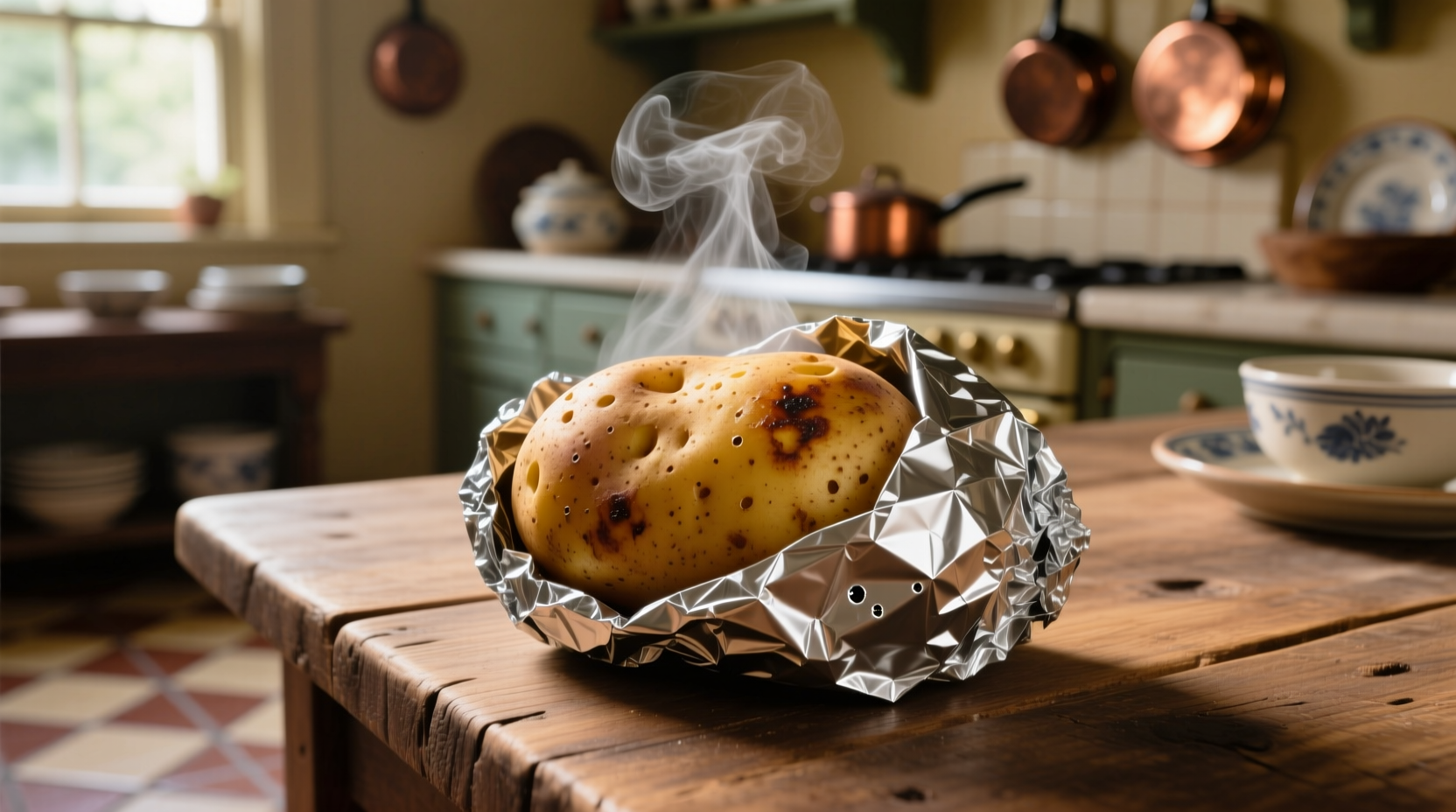The Complete Guide to Baking Potatoes in Foil
Many home cooks reach for aluminum foil when baking potatoes, believing it speeds up cooking or keeps them moist. While foil does work, understanding the science behind this method helps you achieve better results. This guide reveals professional techniques for baking perfect foil-wrapped potatoes every time, based on food science principles and culinary expertise.
Why Foil Changes Your Potato's Texture
When you wrap a potato in foil, you're essentially creating a steam environment. The foil traps moisture released during baking, resulting in a softer, almost boiled texture rather than the crispy skin you get from direct oven exposure. This method works well when you want a tender, uniform texture throughout the potato.
According to the FDA Food Code, proper cooking temperatures are critical for food safety. Potatoes must reach an internal temperature of at least 135°F (57°C) to prevent bacterial growth, but for ideal texture and flavor, aim for 205-210°F (96-99°C).
Step-by-Step Foil Baking Method
- Select appropriate potatoes - Russet or Idaho varieties work best due to their high starch content
- Wash thoroughly and scrub to remove dirt (do not peel)
- Pierce 4-6 times with a fork to allow steam to escape
- Dry completely - moisture helps create steam inside the foil
- Wrap loosely in heavy-duty aluminum foil (shiny side in)
- Place directly on oven rack for even heat distribution
- Bake at 400°F (204°C) for 45-60 minutes depending on size
- Test for doneness by inserting a skewer - it should slide in with no resistance
| Potato Size | Recommended Baking Time | Internal Temperature |
|---|---|---|
| Small (4-6 oz) | 35-45 minutes | 205-210°F (96-99°C) |
| Medium (8-10 oz) | 45-55 minutes | 205-210°F (96-99°C) |
| Large (12+ oz) | 55-65 minutes | 205-210°F (96-99°C) |
Common Mistakes That Ruin Foil-Baked Potatoes
Avoid these frequent errors that lead to disappointing results:
- Tight wrapping - creates excess moisture, resulting in soggy texture
- Skipping the piercing step - can cause potatoes to burst in the oven
- Incorrect oven placement - baking on a sheet pan instead of directly on rack creates uneven cooking
- Not checking internal temperature - visual cues alone don't guarantee proper doneness
- Leaving potatoes in foil after baking - continues cooking and creates mushy texture

Foil Method vs. Traditional Baking: When to Use Each
Understanding the differences helps you choose the right technique for your needs:
- Foil method - Best for quick service restaurants, meal prep, or when you want uniformly tender potatoes without crispy skin
- Traditional baking (no foil) - Ideal when you want crispy skin and more complex flavor development
Food science research from Kansas State University Food Safety shows that baking without foil allows for better Maillard reaction on the skin, creating more complex flavors. However, the foil method provides more consistent internal cooking, especially for larger potatoes.
Pro Tips for Perfect Results
- Room temperature start - let potatoes sit out for 30 minutes before baking for more even cooking
- Oil application - rub with olive oil before wrapping for slightly crispier texture where foil contacts skin
- Resting time - let potatoes rest 5-10 minutes after baking for optimal texture
- Temperature verification - always use an instant-read thermometer for accuracy
- Finishing technique - unwrap and return to oven for 5 minutes if you want slightly crispier skin
Troubleshooting Guide
Fix these common issues with foil-baked potatoes:
- Soggy texture - You wrapped too tightly or left potatoes in foil too long after baking. Loosen the foil wrap and reduce resting time in foil.
- Undercooked center - Increase baking time by 10-15 minutes or raise oven temperature to 425°F (218°C).
- Dry texture - Potatoes were overcooked. Check internal temperature earlier next time.
- Burst potatoes - You didn't pierce enough. Always pierce 4-6 times around the potato.
Food Safety Considerations
When baking potatoes in foil, follow these safety guidelines from the USDA Food Safety and Inspection Service:
- Never leave baked potatoes in foil at room temperature for more than 2 hours
- Refrigerate leftovers within 2 hours of baking
- Reheat to an internal temperature of 165°F (74°C) before serving
- Avoid storing baked potatoes in foil in the refrigerator - transfer to an airtight container
Conclusion
Baking potatoes in foil offers a reliable method for achieving evenly cooked results, particularly useful in commercial settings or when preparing multiple potatoes. While it creates a different texture than traditional baking, understanding the proper technique ensures perfect results every time. Remember to adjust baking times based on potato size, always verify internal temperature, and follow food safety guidelines for the best experience with this classic cooking method.











 浙公网安备
33010002000092号
浙公网安备
33010002000092号 浙B2-20120091-4
浙B2-20120091-4